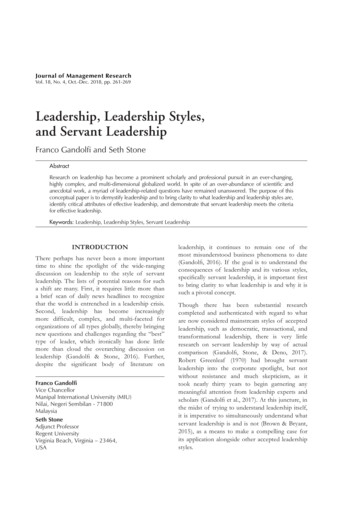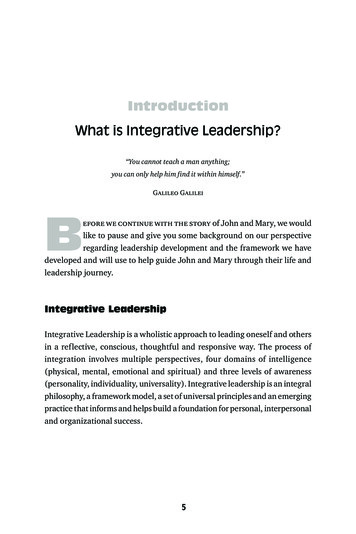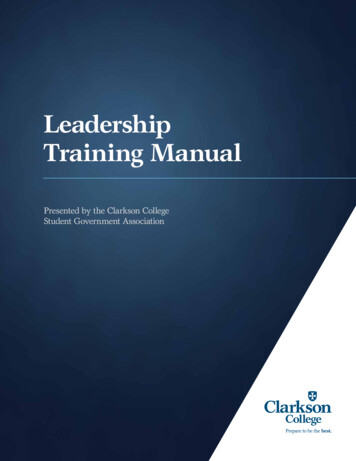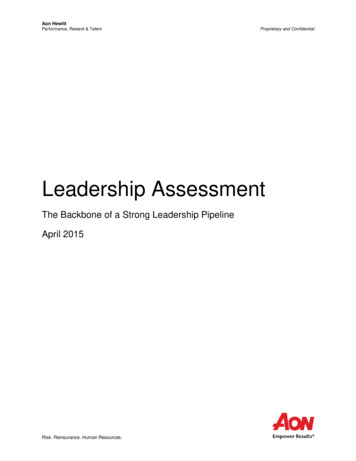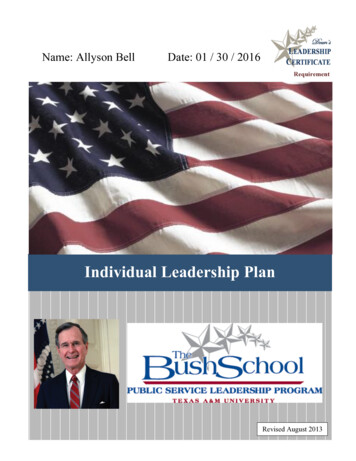
Transcription
Name: Allyson BellDate: 01 / 30 / 2016RequirementIndividual Leadership Plan1Revised August 2013
Individual Leadership Plan“So, the point is not to become a leader. The point is to become yourself, to use yourselfcompletely – all of your skills, gifts, and energies – in order to make your vision manifest. Youmust withhold nothing. You must, in sum, become the person you started out to be, and enjoythe process of becoming.” Warren BennisPersonal Vision Statement3Core Values4Attributes5Skills6Knowledge7Leadership Development Goals8Personal Leadership Plan Worksheet9Action Plan10Skills Matrix11Leadership Competency Framework12Leadership development is a process of learning, self-study and personal growth.A structured action plan can jump-start your momentum for personal developmentand keep you moving toward your goals.The Individual Leadership Plan (ILP) is an ongoing action plan that can be usedto facilitate your development as a leader. In the plan, you assess who you areand envision what you want to become as a leader. In doing so, you willcomplete a Personal Vision Statement, determine your Core Values, and definepersonal and professional Leadership Development Goals for the threecompetency areas for Leadership Development - Knowledge, Skills, andAttributes.Your final challenge will be to determine an Action Plan that guides you throughsteps to take in order to move from your current reality to the achievement of eachgoal.To be a Principled Leader, you must InVEST in Yourself!2
Personal Vision Statement“No man that does not see visions will ever realize anyhigh hope or undertake any high enterprise.” Woodrow Wilson, 28th President of the United StatesBefore you can lead others, you must be able to lead yourself. A personal vision statement entices you tothink about your life, clarify its purpose and identify what is really important to you. Invest timereflecting on the things that are central to your being in order to answer the question, “Who am I and whatis my higher calling?” After writing your vision statement, use it as the standard by which you judge youractivities and choices.The following suggestions from The 7 Habits of Highly Effective People by Stephen Covey may help youcapture what is succinctly central to your being.«A personal vision statement focuses on what you want to be (character) and to do (achievements and contributions) andon the principles upon which being and doing are based.«A personal vision statement becomes a personal constitution, the basis for making major, life-directing decisions, thebasis for making daily decisions in the midst of emotion and circumstances that affect our lives.«The personal vision statement may be written in a variety of ways. Some may choose lists, paragraphs, to poems.“Because each individual is unique, a personal mission statement [should] reflect that uniqueness, both in content andform.”«Once you have a sense of mission/vision, you have the essence of your own proactivity. You have the vision andvalues which direct your life. You have the direction from which you set your development goals. Most importantly,you have the power of a written constitution, against which every decision can be effectively measure.Please create your Personal Vision Statement below.A person with high character, a strong heart, and a passion for serving the people, will neverback down from their personal responsibility to their government.After you have written a draft of your Personal Vision Statement, evaluate it by askingyourself:Do I feel this vision statement represents the integrity I stand for?Are direction, purpose, challenge, and motivation signaled in this vision statement?Am I aware of the strategies and skills that will help me accomplish what I have written?If I were to share my Personal Vision Statement with the world, is this an accurate portrait of who I want to be?Final Test: Does this vision statement inspire me?Please create your 3-5 word Mantra (optional).Never give up, always work harder.3
Core ValuesIt’s not hard to make decisions when you know what your valuesare.” Roy DisneyYour core values are the principles you use to govern your life and define integrity and ethics for you. Effectiveleaders hold fast to these standards and do not waver, using them to help weigh choices in life. Every effectiveleader has a list of things they believe to be of worth, quality or esteem. They are the things the leader prizes and iswilling to “go to bat” for.Your values will most likely compliment your Personal Vision Statement. Furthermore, make sure any goals andaction plans you develop are consistent with your values.To prioritize your values, identify 8-12 that are most important to you below.Achievement – some sense of accomplishment, mastery, goal attainmentAdvancement – growth, seniority, and promotion resulting from work well doneAdventure – some sense of accomplishment, mastery, goal attainmentAffiliation – interaction with other people, recognition as a member of a particular group, involvement, belongingAffluence – high income, financial success, prosperityAuthority – position and power to control events and other peoples’ activitiesAutonomy – ability to act independently with few constraints, self-reliance, ability to make decisions/choicesBalance – lifestyle that allows for a balance of time for self, family, work, and communityChallenge – continually facing complex and demanding tasks and problemsCollaboration – close, cooperative working relationships with groupsCommunity – serving and supporting a purpose that supersedes personal desire, “making a difference”Competency – demonstrating high proficiency and knowledge, showing above-average effectiveness and efficiency at tasksCompetition – rivalry with winning as the goalCourage – willingness to stand up for one’s beliefsCreativity – discovering, developing, or designing new ideas, formats, programs, or things; demonstrating innovation and imaginationDiverse Prospectives – unusual ideas and opinions, points of view that may not seem right or popular at first but bear fruit in long runDuty – respect for authority, rules, and regulationsEconomic Security – steady and secure employment, adequate financial reward, low riskEnjoyment – fun, joy, and laughterFame – prominence, being well knownFriendship – close personal relationships with othersHealth – physical and mental well-being, vitalityHelping Others – helping people attain their goals, providing care and supportHumor – the ability to laugh at oneself and lifeInfluence – having an impact or effect on the attitudes or opinions of other peopleInner Harmony – happiness, contentment, being at peace with oneselfIntegrity – acting in accordance with moral and ethical standards; honesty, sincerity, truth, trustworthinessKnowledge – the pursuit of understanding, skill, and expertise; continuous learningLoyalty – faithfulness; dedication to individuals, traditions, or organizationsPersonal Development – dedication to maximizing one’s potentialResponsibility – dependability, reliability, accountability for resultsSelf-Respect – pride, self-esteem, sense of personal identitySpirituality – strong spiritual or religious beliefs, moral fulfillmentWisdom – sound judgment based on knowledge, experience, and understandingFrom the values selected above, identify 3-5 Core Values that align most closely with ‘Who you are” (fromPVS) and “Who you want to be.”1. Personal Development2. Achievement3. Influence4. Knowledge5. Autonomy4
Attributes Analysis“Imagine the [leadership] styles, then, as the array of clubs in a golf pro’s bag the pro‘senses’ the challenge ahead, swiftly pulls out the right tool, and elegantly puts it towork.” Goleman, Boyatzis, McKeeEffective leaders know their personal strengths, their areas in need of improvement, the characteristics they displayin their relationships with others, and their preferences towards specific situations. They also understand that takingstrategic and proactive approaches to developing and managing their professional image pays off. In summary,effective leaders have self, social, and situational awareness, and manage themselves and their relationships.The good news is that you can be the author of your own identity. Spend some time below reflecting on yourapproach and needs for developing your own image.Your Desired Professional ImageWhat do you want key constituents to say about you when you are not in the room (your core competencies andcharacter traits)?I want people to say that I am a loyal, hard-working, caring person who values family, friends, and work,and who serves all three to the best of my abilities.Your Current Image, Culture, and Audience.What are the expectations for professionalism in the field you are pursuing?I plan to work in city administration and this field is expected to be hard working, self reliant, innovative,upholding moral standards, possess leadership ability, and able to put your best face foreward to thepublic no matter what.How do others currently perceive you?I believe other perceive me self reliant, loyal, hard working, competent, strategic, and serious.Strategic Self-PresentationWhat stereotypes correlate with your intended profession and how will you handle them?Stereotypes of my intended professionalism are that people in this field are corrupt, motivated bypartisanship, or “Parks and Recreation” characters. I plan to counteract this by being honest, transparent,take my job seriously, and uphold professional etiquette when representing the public.How will you build credibility while maintaining authenticity?I will build credibility while maintaining authenticity by holding true to my moral fibers and characterillustrating this to others through my actions and words.Cost Benefit Analysis for Image ChangeDo you care about other’s perceptions of you?No I do not care about other’s perceptions of me generally unless it is a close friend, family member, orrespected collegue. I find these to be the most accurate and useful perceptions to pay attention to.Are you capable of changing your image and are the benefits worth the costs (cognitive, psychological, emotional,physical effort)?Yes I am capable of changing my image, but the benefits are not worth the costs because I do not want toloose sight of who I am as an individual and I want to hold true to my character. Additionally, I do not seethe need to.Information for “Attributes Analysis” was retrieved from an article by Mallory Spark about Professor Laura Morgan Roberts’ expertise in Professional Imageshttp://hbsworkingknowledge.hbs.edu5
Leadership SkillsSkills are the abilities that leaders use to translate their syles, strategies and plans, tools and techniques into practice.Identifying skills for development requires a level of self-reflection (Step 1) to determine those skills you havedeveloped and used in previous leadership/professional opportunities. It also requires self-trajection (Step 2),thinking about the skills that will be important to your future success.Step 1:Identify skills you have developed and used in previous leadership/professional opportunities. In particular, thinkabout skills that make you marketable to a prospective employer. The goal is not only to list what you are good atdoing, but also to produce solid examples of how you previously applied those skills in work or leadership positionsto achieve positive outcomes.For guidance, please access the “Skills Matrix” attachment at the end of this document.SkillHighlight the task, method, purpose, value, and outcome. (from Skills Matrix)Time ManagementManage time across two organizations, graduate assistanship, job search, and 12 hoursof classes.Professional DevelopmentContinue to develop professionally throughout my coursework, assistantship, andorganizations.Managing Personal StressManage stress by prioritizing school and sleeping more.Financial ManagementGreater understanding of the government budgeting and financial management.Developing Self AwarenessDeveloped self awareness to understand how I operate with others & to critique selffor improvementStep 2:Below is a list of skills that many organizations, government agencies and large/small businesses deem important forleadership roles. Put a check by those skills that you feel you could improve. Another way to identify skills thatorganizations deem important is to find a job description in the area you are most interested in for a career. Circlethe skills outlined in the job description that you need to attain or further develop. You might choose to focus onskill areas that you are already good at, but by strengthening them, you will be a more effective leader.Personal SkillsDeveloping Self AwarenessManaging Personal StressSolving Problems Analytically and CreativelyInterpersonal SkillsCoaching, Counseling, and SupportiveCommunicationGaining Power and InfluenceMotivating OthersManaging ConflictGroup SkillsEmpowering and DelegatingBuilding Effective Teams and TeamworkManaging ChangeTechnical SkillsMaking Oral and Written PresentationsPolicy AnalysisEconomic AnalysisPersonnel ManagementBudgetingProject ManagementLanguage ProficiencyOther Skills (Think about the skills that jobannouncements in your intended field emphasize)Human Resource ManagementPublic FinanceInfrastructure PlanningBond Election Process knowledgeCommunity relationsCommunity involvement (service)Step 3:From Steps 1 & 2, identify 1-3 skills on which you would like to focus. As you continue to complete yourIndividual Leadership Plan, you will reflect on these skill areas and develop goals related to them.1. Empowering &2. Making Oral Presentations3. Self-AwarenessDelegating6
Knowledge“A hallmark of achievement is in continually learning – and teaching – ways to dobetter.” Goleman, Boyatzis, McKeeEffective leaders spend time studying the field of leadership and management. All leaders need information, andthey have to be able to process that information in the best manner possible. Effective leaders know when to becritical and analytical in their thinking, when to be creative, and when to take the time to think conceptually.On the previous page, you identified potential areas of growth for leadership skills. Webster’s Dictionary definitionfor skill: the ability to use one's knowledge effectively and readily in execution or performance. Complete thefollowing matrix, which will help you determine particular areas where you should gain more knowledge and/orexperience for the skills identified on page 6.You do not have to complete the matrix. If you only chose 2 skills, just fill in 2 lines.Skills (transferredfrom page 6)Ex.Managing ChangeWhat do youunderstand?What Experience doyou have?What DevelopmentNeeds do you have?Change is inevitable; not beingopen to change risks personal andprofessional growth; most peoplehave a negative attitude towardchange.Leader of an organization thatwas analyzing past goals andobjectives and creating new onesin order to better serve membersand community.Gain information and experiencein how to get others motivatedabout change; create changewithout setting off a state ofpanic1. Empowering &DelegatingI understand it isnecessary to delegatetasks and empowerothers to do and buildskills.I have pushed myself toempower others anddelegate tasks throughmy role as projectmanager in capstone.2. Making OralPresentationsI understand how togive an effectivepresentation and how toengage the audience ona basic level.I have pushed myself topresent a lot thissemester by presentingevery opportunity Ihave.I need to develop betterempowerment skills sothat when I delegate, theperson feels confidentabout doing the task. Iwant others tounderstand that when Igive them a task, it isbecause I know they canaccomplish it.Continued practice anddevelopment of skillsthrough making myselftry, review, andimprove.3. Developing SelfAwarenessI am self-aware of who Iam, how I could beperceived, and how tomarket myself.I have learned throughself-assessments,feedback from family,friends, and trustedcolleagues.I need to develop betterself-awareness when itcomes to reading in themoment how others are“reading” me.7
Leadership Development GoalsUsing the information obtained from analyzing your Attributes, Skills, and Knowledge, develop 2-3 STRETCHLeadership Development Goals and 1-2 Manageable Goals per STRETCH Goal. Although you may be enticedto develop multiple goals, studies show that working on too many goals could decrease the probability of achievingany of them.STRETCH Goals are challenging goals that will result in a breakthrough toward reaching your Personal VisionStatement.MANAGEABLE Goals are *S.M.A.R.T. goals that will help you get started toward your STRETCH Goals andVision.« STRETCH Goal : Empowering & Delegating§ Manageable Goal: Delegate tasks weekly in capstone.§ Manageable Goal: Make a point to encourag and empower team members.« STRETCH Goal : Stregthen my abilities to make oral presentations.§ Manageable Goal: Reherse and give oral presentations this semester to increase confidence.§ Manageable Goal: Work on improving my oral presentation abilities in courses and in myorganizations.« STRETCH Goal : Developing Self-Awareness§ Manageable Goal: Reflect on how I come off in different situations at school, work, and in myorganization meetings to others, especially across diverse people.§ Manageable Goal: Implement self-awareness as I operate and be thoughtful in my interactionswith others.*Use the 5 S.M.A.R.T. Goal Guidelines below:Specific—a specific goal has a much greater chance of being accomplished than a general goal. Ask yourself the six “W’s” (Who, What, Where,When, Which, Why)Measurable—establish concrete criteria for measuring progress toward attaining each goal. When you measure your progress, you stay on track.To determine if they are measurable, ask questions such as How much? How many? How will I know when it is accomplished?Attainable—when you identify goals that are most important to you, you begin to figure out ways you can make them come true. You can attainmost any goal you set when you plan your steps wisely and establish a time frame that allows you to carry them out.Realistic—to be realistic, a goal must represent an objective toward which you are both willing and able to work. Your goal is probably realisticif you truly believe that it can be accomplished. Ask yourself what conditions would have to exist to accomplish the goal.Timely—a goal should be grounded within a time frame. With no time frame tied to it there’s no sense of urgency. “Someday” won’t work, butif you anchor your goal within a timeframe, then you’ve set your unconscious mind into motion to begin working.8
Personal Leadership Plan Worksheet“Leaders don’t rise to the pinnacle of success without developing the right set of attitudesand habits; they make every day a masterpiece.” John MaxwellDecide on 1-3 leadership goals you want to achieve within six months. Use SMART* goals in your actionplanning. List 4-6 additional goals for your one to two year plan. Your results will improve if you work witha coach. Please see Attachment #2 for additional information about the Leadership Competency Framework(K, S, A, V).Complete the plan below and use the information to jump-start your development.CATEGORY(K, S, A, ttributeGOALACTIONRESOURCESDEADLINELearn to give improved oralpresentations.Learn through practicingoral presentations in myclasses.My professors, peers,and my own critiqueand advice.By Spring 2016.Gain knowledge regarding urbanplanning, zoning, development, andsustainability.Learn through internshipapplied work andcoursework next yearMy supervisors, theprojects I wok on, andmy professors next yearBy Spring 2016My friends, family, andgroup members providehonest feedbackBy Spring 2016Improve supportive communicationand counseling abilitiesImprove throughpracticing bettersupportivecommunication skillsand counselng withingroup and personalsettingsMaster expository writing styleMaster throughpracticing this writingstyle in my classes.My professors,specifically Dr. Kerr,for feedback andcritique.By Spring 2016.Increase proficiency in MicrosoftExcelImprove skills inMicrosot ExcelDr. Justin Bullock andtextbooks in Quant. II;through use in capstoneBy Spring 2016.Develop full business wardrobe.Buy pieces over time.Career center dressguides and imageconsultantBy Spring 2016.9
Action Plan“Authoritatively setting directions about performanceaspirations has multiple benefits: it energizes teammembers, it orients their attention and action, and itengages their talents.” J. Richard HackmanYour Action Plan identifies very specific steps you will take, resources you will locate, and the support systemyou will build to reach your Leadership Goals and work toward your Personal Vision. It moves you from“Current Reality” to achieving your goals.Complete the plan below and use the information to jump-start your development.Goal #1Empowering &DelegatingGoal #1Making OralPresentationsGoal #1Developing SelfAwarenessSpecific Actions to Take1. Delegate tasks to thosewho skills fit best.2. Empower others throughassurance, praise, andencouragement.Specific Actions to Take1. Reherse and practiceoral presentations2. Give oral presentation topeers3. Receive feedback4. Practice changes5. Volunteer moreSpecific Actions to Take1. Be thoughtful in allinteractions2. Reflect on self andother’s perception of me3. Continue learning aboutself.Resources to AssistDevelopment1. Dr. Kerr in capstone2. Trusted colleaguesResources to AssistDevelopment1. Bush School Professors2. Bush School PeersResources to AssistDevelopment1. Set aside time to reflect2. Feedback from family,friends, and trustedcolleagues3. HollyTimeline1. May 2016Timeline1. Continue tovolunteer and givepresentations inclass to developskills; usefeedback to betterpresentationabilities .Timeline1. May 201610
Attachment 1:Skills MatrixSince the job search process mirrors that of a marketing campaign the first step is to identify the customer and his orher wants and needs. After determining what the customer, or in this case the employer, wants you must determinewhether and how you can meet their requirements.Step 1:Potential employers want to hear about specific skills you can contribute that will strengthen their organization.Take some time to reflect on what specific knowledge, skills and abilities you can contribute to an organization atthis point in your career. Your previous leadership, volunteer and work experiences are a good starting point in thisself-reflection.Step 2:Build the matrix by describing the following:1. What did you do? (the task)2. How did you do the task? (the method)3. Why did you do the task/use this method or for whom did you complete the task? (the purpose or the valueyou brought)4. What were the results? (positive outcome)Note that this matrix will grow throughout your academic and professional career and will benefit you through thejob search process and enhance your career management success. In the job search process, this matrix will help youin targeting your resume to meet the needs of the job in which you are applying, writing a cover letter, interviewingand networking.Points to note: You may have multiple examples or only one example for each skill. Quantify whenever you can. How many? How much? Dollars? Percentages? Think along the lines of how you purchase products or services. You want to know what something does,how, why, and the results. Those are all needed to close the sale of a product or service – that is no differentthan what you are trying to do as you search for a job.11
SkillWhat did you do?(the task)How did you do it?(the method)NegotiationNegotiated t-shirtpriceTimeManagementInvolved in twoorganizations as anofficer and managed12 hours of classes.Developprofessionallythroughoutinternship withCounty and City.Compared competitorprices, communicatedprice difference tocompany of choiceSet priorities, utilized todo lists, budgeted timeeffectively, and setboundariesLearned fromsupervisors, versedmyself in professionalstandards, and practiceddaily.ManagePersonal StressLearned to managepersonal stress byprioritizing relaxingactivities.Learned to prioritize freetime and enjoyableactivities into myschedule.To allow myself amental breaks and torelieve stress.HumanResourceManagementGainedunderstanding ofhuman resourcemanagementpractices and lawsLearned through myclass with Dr. Grahamand Dr. Bullock and thereadingsAllows me to betterwork in citymanagement becauseoften times HR workbleeds over into the citymanager’s officeDevelopingSelfAwarenessLearned how Ioperate withothers/environmentsand gained ability tocritique myself forimprovementLearned throughleadership exercises,working with peers, andreceiving feedback.Helps me become abetter leader and teammemberProfessionalDevelopmentWhy did you do it?(the purpose or thevalue you brought)Save organizationmoneyWhat were theresults?(positive outcome)35% savings, whichtotaled 2,800.Allowed me to betterserve each of mycommitmentsOffice in bothorganizations now,and maintainingdesired GPAHighrecommendations tointernship thissummer and had nodifficulty obtainingitLess stressed overalland better rested thissemester which hasimproved myperformanceMore qualified towork in entry levelHR positionsbecause of work andprojects; better ableto work with the citythis summerWill translate toprofessional careerand internshipwhere working withothers is criticalTo better myself andmy careeropportunities; Citymanagement is smallfield12
Attachment 2:Leadership Competency FrameworkStarts with Vision:Who am I?What do I want tobecome?13
Individual Leadership Plan Warren Bennis Leadership development is a process of learning, self-study and personal growth. A structured action plan can jump-start your momentum for personal development and keep you moving toward your goals. The Individual Leadership Plan (ILP) is an ongoing action plan that can be used


